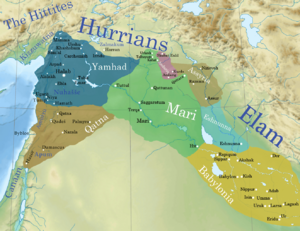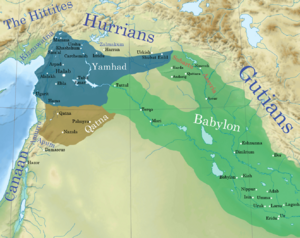Shamshi-Adad I facts for kids
Quick facts for kids Shamshi-Adad I |
|
|---|---|
| King of the Universe Pacifier of the Land between Tigris and Euphrates |
|

Line-drawing of an incomplete seal of Shamshi-Adad I
|
|
| King of Upper Mesopotamia | |
| Reign | c. 1808–1776 BC |
| Successor | Ishme-Dagan I (Assur and Ekallatum) Yasmah-Adad (Mari) |
| Died | c. 1776 BC Šubat-Enlil |
| Akkadian | Šamši-Adad |
| Amorite | Shamshi-Addu |
| Father | Ila-kabkabu |
Shamshi-Adad (also known as Shamshi-Addu) was a powerful king who lived a long time ago, from about 1808 to 1776 BC. He was an Amorite, a group of people from ancient Mesopotamia. Shamshi-Adad was a great leader and a conqueror. He built a large kingdom that stretched across parts of Syria, Anatolia (modern-day Turkey), and Upper Mesopotamia (the northern part of what is now Iraq and Syria).
Contents
How Shamshi-Adad Rose to Power

Shamshi-Adad I became king of a city called Ekallatum. He took over from his father, Ila-kabkabu. Even though his father was a king, Shamshi-Adad I did not simply inherit a large empire. He had to conquer lands to build his own kingdom.
At one point, Shamshi-Adad I had to leave Ekallatum. This happened when another powerful king, Narām-Sîn of Eshnunna, attacked his city. Shamshi-Adad I went to Babylon to stay safe. He waited there until Narām-Sîn died.
After Narām-Sîn's death, Shamshi-Adad I returned. He took back Ekallatum. Then, he went on to conquer Assur, a very important city. Around 1808 BC, he became the first Amorite king of Assyria.
In Assur, Shamshi-Adad I called himself "Governor of Assur." He also claimed to be "King of the Universe." He said he was the "Unifier of the Land Between Tigris and Euphrates" rivers. He even built a temple for the god Assur.
Shamshi-Adad's Conquests
Shamshi-Adad I was very ambitious. He took over an old, empty town called Shekhna. He turned it into his new capital city and renamed it Šubat-Enlil. This name means "the residence of the god Enlil."
One of his main goals was to control the city of Mari. Mari was important because it was on a major trade route. The king of Mari, Yahdun-Lim, was killed. Some people think Shamshi-Adad I might have been involved.
Shamshi-Adad I quickly took over Mari in 1796 BC. He then put his two sons, Ishme-Dagan I and Yasmah-Adad, in charge of important areas. His oldest son, Ishme-Dagan I, ruled Ekallatum. His second son, Yasmah-Adad, ruled Mari. Shamshi-Adad I himself stayed in Šubat-Enlil.
By taking Mari, Shamshi-Adad I created a huge empire. It covered much of Syria, Anatolia, and all of Upper Mesopotamia. This empire was often called the "Kingdom of Upper Mesopotamia." Shamshi-Adad I proudly called himself "King of All." This was a title used by a famous ancient king named Sargon.
Shamshi-Adad I also made an alliance with King Dadusha of Eshnunna. Together, they conquered lands between two rivers called the Zab. However, Shamshi-Adad I later attacked some of Dadusha's cities. He was a very skilled military leader. His army knew how to plan attacks and use tools like battering rams to break down city walls.
Shamshi-Adad's Family Life
Shamshi-Adad I kept a close eye on his sons. He wrote many letters to them, giving them instructions. For example, he arranged a political marriage for his son Yasmah-Adad. Yasmah-Adad married Beltum, who was a princess from the kingdom of Qatna.
Yasmah-Adad already had another wife. He tried to make Beltum less important. But Shamshi-Adad I did not like this. He made sure Beltum was treated as the main wife in the palace.
Shamshi-Adad I also wrote to Beltum's father, the King of Qatna. In his letter, he talked about their alliance and how their children's marriage was going well.
How Shamshi-Adad Ruled
Shamshi-Adad I was a very organized ruler. He controlled everything in his kingdom. This included big decisions about the government and smaller things like appointing officials. He even managed the supply of food and goods.
He often used spies and propaganda to gain control over rival cities. When he conquered new lands, he sometimes allowed the local rulers to stay in charge. However, these local rulers had to become his "vassals." This meant they had to obey him and pay him tribute.
In the city of Nineveh, he used government money to rebuild the Ishtar temple. He also made sure that a special dating system, called the Assyrian Eponym dating system, was used throughout his empire.
The Fall of Shamshi-Adad's Empire

Shamshi-Adad I worked hard to make his kingdom strong. But as he grew older, his empire became more vulnerable. Nearby powerful kingdoms, like Yamkhad and Eshnunna, started to attack. His empire was also in a difficult location, making it hard to defend.
Shamshi-Adad I's success made other kings jealous. Throughout his rule, he and his sons faced many threats. After Shamshi-Adad I died, his empire began to crumble. Eshnunna quickly captured cities around Assur.
When news of his death spread, his old enemies tried to take back their lands. His son Yasmah-Adad was soon driven out of Mari. The rest of the empire was eventually lost. First, it fell to a group of kingdoms including Mari and Eshnunna. Later, another powerful Amorite ruler, Hammurabi of Babylon, took over.
See also
 In Spanish: Shamshiadad I para niños
In Spanish: Shamshiadad I para niños
- Assyrian continuity
- List of Assyrian kings
- Timeline of the Assyrian Empire
- Chronology of the ancient Near East
Images for kids
-
A map of the Ancient Near East showing the Kingdom of Upper Mesopotamia (light brown) and other powerful kingdoms around 1808 BC.
-
A map of the Ancient Near East showing the situation after Hammurabi's conquests around 1750 BC.
| Preceded by Erishum II |
Issi’ak Assur 1808–1776 BC |
Succeeded by Ishme-Dagan I |




